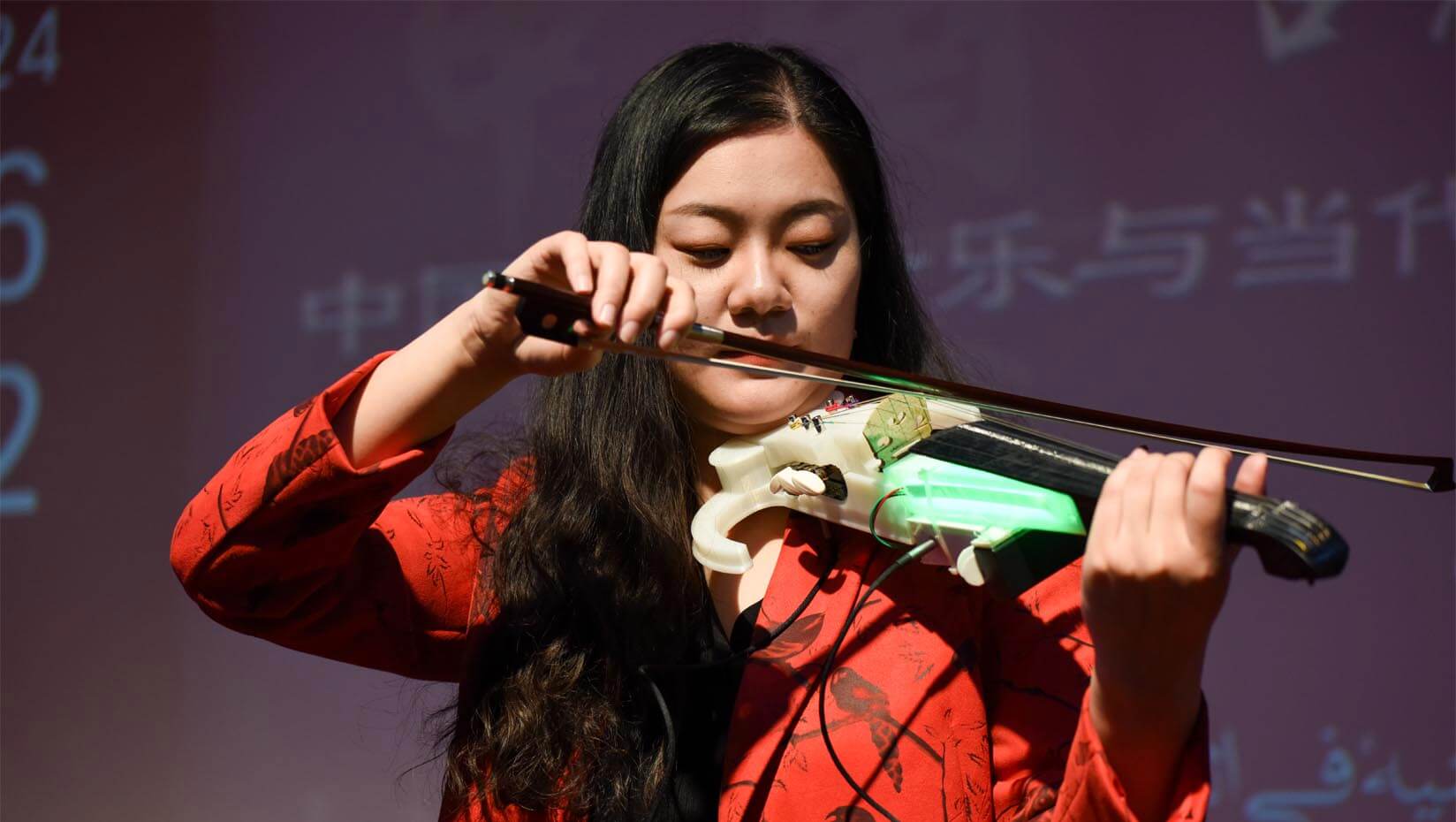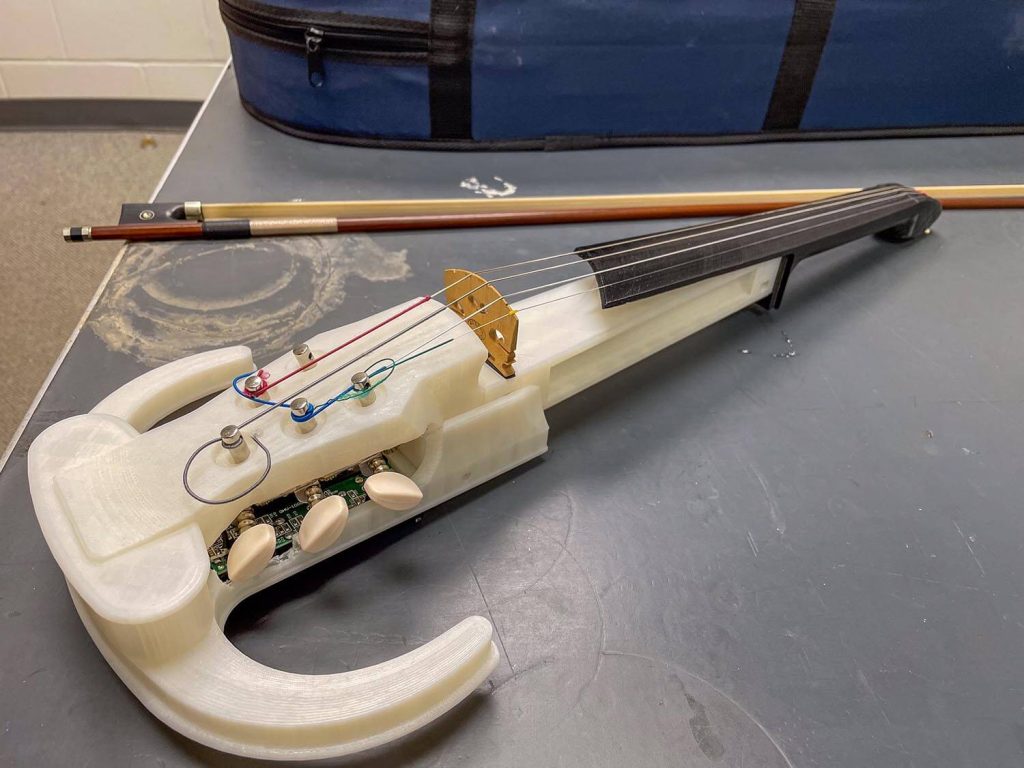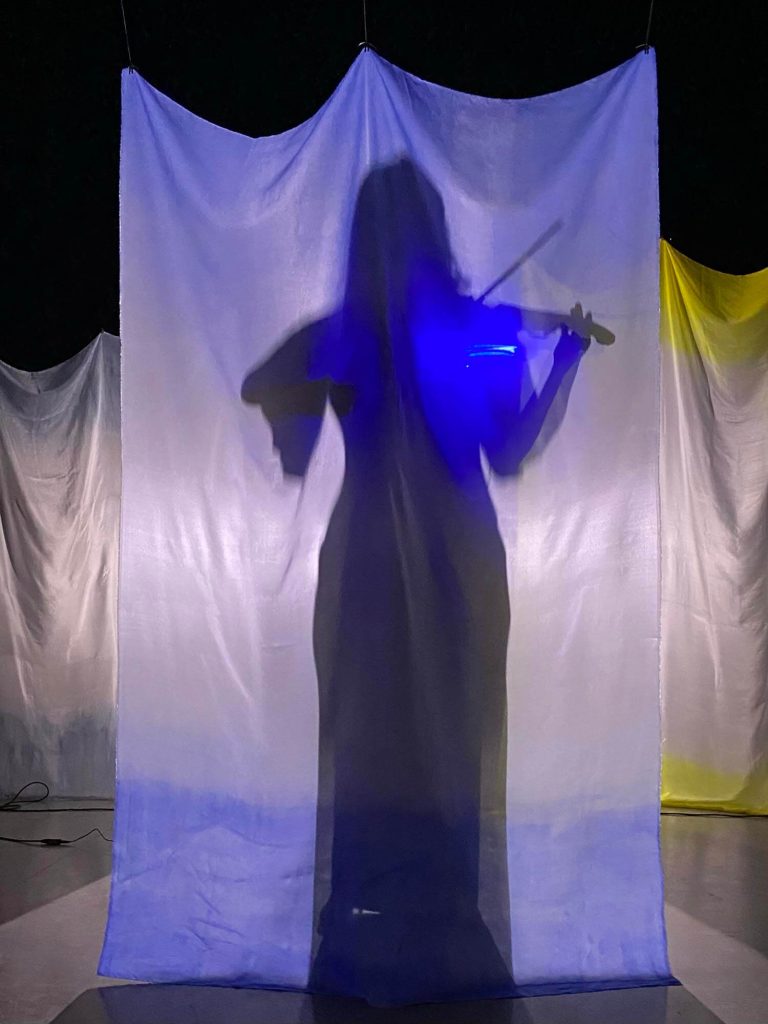
Student and her 3D-printed instrument harmonize classical music with digital age
A University of Maine Interdisciplinary Ph.D. candidate tapped into the flagship university’s 3D-printing prowess to create educational musical performances that are as exciting to see as they are to hear.
Ruixin Niu draws from her background as a violist, violinist and conductor to meld data-driven innovation with musical performance. To command her audience’s attention and grasp of Chinese pentatonic music, Niu sought to create an instrument unlike any other: a first-of-its-kind 3D-printed violin/viola hybrid. She developed the novel instrument over several months in collaboration with engineering students at HackerSpace. The transparent PLA material the instrument is made of allows lights inside to glow with different colors in response to the notes she plays. As Niu draws her bow across the strings of her 3D-printed instrument, music and light illuminate a history of creative expression and cultural exchange.
Niu, who is advised by Susan Smith, associate research professor and graduate coordinator of UMaine’s Intermedia Program, also transforms the stage on which she performs into an exhibit, using light, color and artistry to inform as she performs. She incorporates silk projection and multimedia displays in her performances, creating an immersive environment to help her audience connect with the music.
Her avant-garde approach to classical music creates immersive performances that aim to enthrall concert-goers who are numbed to external stimuli by the constant distractions of the digital age.
“In an era characterized by shorter attention spans and ubiquitous distractions, the integration of visual technology has become increasingly vital in capturing and maintaining audience engagement. By incorporating visual elements such as 3D printed instruments with color-coded lighting, silk projection and installation, and multimedia displays,” Niu wrote in her dissertation proposal, “musicians can create immersive experiences that facilitate audience connection with the music. Furthermore, technology offers opportunities to make diverse genres of music more accessible to audiences, while fostering interdisciplinary collaborations that break down traditional boundaries between art forms and engage multiple senses.”
Her idea was inspired by the subtle differences between the five modes of Chinese pentatonic music, which may be missed by those accustomed to the two major and minor scales of Western music. Her use of visual technology helps her performances bound over these cultural barriers of music appreciation and expression.
“It started from the idea to better present this kind of music because the differences between those different scales is very subtle. So with the help of light and visuals, people can easily distinguish the different modes,” Niu said. “By using technology, we can help the audience to better understand and appreciate the music that they are not familiar with.”
She came to UMaine to study intermedia to pursue Intermedia studies, due in part to its world-renowned reputation in 3D-printing. A boat printed at the university’s Advanced Structures and Composites Center made headlines worldwide and caught her attention as she was wrapping up her second master’s degree in viola pedagogy at the Royal Conservatory of Music in Liege, Belgium.
A musician from the age of four, Niu has studied and performed music around the globe. She earned a bachelor’s degree in music education from Nanjing Normal University and a Master of Viola Performance at the Central Conservatory of Music in Beijing. During her first master’s degree program, she also studied at Geneva University of Music in Geneva, Switzerland. Her later studies in Belgium and at UMaine, coupled with her performances like one she recently held in Paris, grew her appreciation for cross-cultural exchange and the ability of music to connect people across languages and cultures.
Chinese pentatonic music can be traced through history to the Silk Road, which facilitated a wide variety of artistic exchanges. As music transcended cultural boundaries and languages, it spurred creative innovation across civilizations. Niu draws from this storied past for her own research, looking back through history to study the influences of Arabian, Italian and other Western music on Chinese music as a result of trading along the Silk Road.
The Chinese pentatonic modes also correlate with the Five Elements theory of Earth, Metal, Wood, Fire and Water as being the primary elements of existence, each with its own characteristics, properties and symbolic associations. Niu has been incorporating the Five Elements theory into her musical performances to help enhance the audience’s experience by integrating the natural world with a conceptual framework of human experience.
Niu’s research also includes studying the Eight Tones and Eight Trigrams to help create a richer visual experience for her audience. The Eight Tones is an ancient Chinese theoretical concept which categorizes music into eight different varieties, and the Eight Trigrams uses a fundamental Daoist philosophical concept that categorizes eight fundamental forces or elements in the universe.
In April 2025, Niu will stride onto stage for the culminating performance of her UMaine education. The collaborative performance will feature contributions from UMaine Intermedia students and the Guqin, one of the oldest Chinese musical instruments, performed by Simon Debierre, a collaborator on Niu’s Silk Road project.
As digital technology advances and many people may become more desensitized to external stimuli, Niu’s said she hopes to ameliorate the disconnect by enhancing the musical experience with light, color, immersion, installation and artistry to inform just as much as she performs.
Contact: Erin Miller, erin.miller@maine.edu


